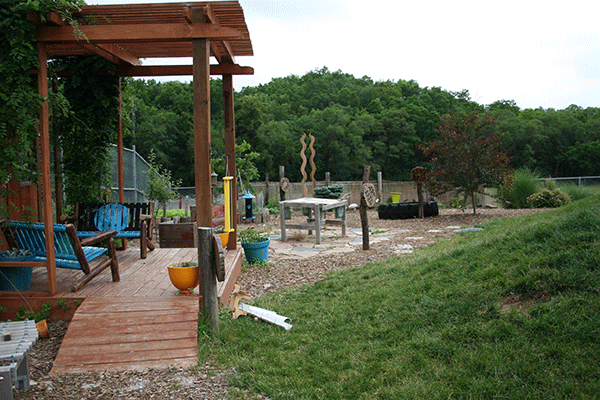What does a playground look like? Most of us over the age of 30 have memories of wooden seesaws, sand piles, swings on tall wooden poles, metal slides and dirt or sand to run through barefoot. Times have changed. A quick search for “natural playgrounds” will take you to a whole host of websites selling plastic play equipment.
In a strange paradox, the more imaginative the structures are (towers, forts and houses), the less likely children are to use them as props for their own imaginative journeys; while the more mundane the structures and elements are, the more likely they are to foster creative play. One simple example of this occurs every Christmas when the large box holding a toy is turned into a house, a sled, an easel, a train track, while the toy remains… a toy.
Was it our concern with safety that ruled out wood that can give splinters, sand that can get into eyes, metal that gets hot in summer sun, anything that can pinch small fingers? Much has been lost in the process of domesticating our playgrounds, but it can be reclaimed.
Elements of Natural Playgrounds
Fundamental to imaginative play is the ability to create, change or imprint your environment. The best way to do that in a landscape is to allow some “loose parts” that can be changed and rearranged. Sticks, stones, sand, old boards, shells, water and seedheads provide flexible props for creative play.
Mounds of soil can be turned into slides. With the addition of water, sand and soil become mud pies or sand castles or can be formed into gullies that manipulate water movement. Stumps and stones offer opportunities for balancing and jumping. Trees, shrubs, tall grasses and old twigs can help form the structure for a fort or lean-to.
One of the best things about a natural playground is that it is equally inviting and accessible to everyone, and it can be enjoyed just as thoroughly by one child as by a whole group. There is no hierarchy of skill or ability… all that’s necessary is interest and attentiveness.
Many playgrounds are paved or covered but only 14 percent of children would choose a paved surface over a natural one, according to a survey by the Children’s Play Council. Still, it can be a challenge for parents accustomed to a manicured lawn to set aside part of it for creative play. But the play materials don’t have to require a lot of space and they can be placed in slightly out-of-the-way areas.
Space for Children's Gardens
Allowing kids the freedom to grow their own plants and gardens can be even more of an “aesthetic” challenge but it’s a great opportunity for young people to learn about the way plants grow; experiment with plants they can eat, smell or touch; attract butterflies, birds or other pollinators; and learn some responsibility at the same time. The simple addition of a magnifying glass offers a closer look at flowers, bark or bugs near at hand while binoculars offer the same possibility for things farther away.
School is out, children are home and, with a few loose parts and some imagination, endless opportunities for creative play are right out the backdoor.
Nebraska Statewide Arboretum is a nonprofit that works toward sustainable home and community landscapes through initiatives in education, public gardens and the environment. Plant and landscape resources at http://arboretum.unl.edu.

